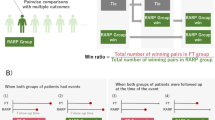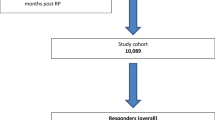Abstract
Background:
Few studies have analyzed factors that influence longitudinal changes in patient-perceived satisfaction during the recovery period following robot-assisted radical prostatectomy (RARP) for prostate cancer. We investigated variables that were associated with patient-perceived satisfaction after RARP using the expanded prostate cancer index composite (EPIC) survey.
Methods:
Of 175 men who underwent RARP between 2010 and 2011, 140 men completed the EPIC questionnaire preoperatively and 3, 6 and 12 months postoperatively. On the basis of the EPIC question no. 32 (item number 80), patients were divided into four groups according to the pattern of satisfaction change at postoperative 3 and 12 months: satisfied to satisfied (group 1); satisfied to dissatisfied (group 2); dissatisfied to satisfied (group 3); and dissatisfied to dissatisfied (group 4). Longitudinal changes in EPIC scores over time in each group and differences in EPIC scores of each domain subscale between groups at each follow-up were analyzed. A linear mixed model with generalized estimating equation approach was used to identify independent factors that influence overall satisfaction among repeated measures from same patients.
Results:
On the basis of the pattern of satisfaction change, groups 1, 2, 3 and 4 had 103 (74.3%), 21 (15.0%), 11 (7.9%) and 5 (2.9%) patients, respectively. The factor that was associated with overall satisfaction was urinary bother (UB) (β=0.283, 95% confidence interval (0.024, 0.543 ); P=0.033) adjusted for other factors under consideration.
Conclusions:
UB was the independent factor influencing patient-perceived satisfaction after RARP. During post-RARP follow-up, physician should have the optimal management for the patient’s UB.
This is a preview of subscription content, access via your institution
Access options
Subscribe to this journal
Receive 4 print issues and online access
$259.00 per year
only $64.75 per issue
Buy this article
- Purchase on SpringerLink
- Instant access to full article PDF
Prices may be subject to local taxes which are calculated during checkout


Similar content being viewed by others
References
Fulmer BR, Bissonette EA, Petroni GR, Theodorescu D . Prospective assessment of voiding and sexual function after treatment for localized prostate carcinoma: comparison of radical prostatectomy to hormonobrachytherapy with and without external beam radiotherapy. Cancer 2001; 91: 2046–2055.
Zeliadt SB, Ramsey SD, Penson DF, Hall IJ, Ekwueme DU, Stroud L et al. Why do men choose one treatment over another?: a review of patient decision making for localized prostate cancer. Cancer 2006; 106: 1865–1874.
Altwein J, Ekman P, Barry M, Biermann C, Carlsson P, Fossa S et al. How is quality of life in prostate cancer patients influenced by modern treatment? The Wallenberg Symposium. Urology 1997; 49: 66–76.
Madalinska JB, Essink-Bot ML, de Koning HJ, Kirkels WJ, van der Maas PJ, Schroder FH . Health-related quality-of-life effects of radical prostatectomy and primary radiotherapy for screen-detected or clinically diagnosed localized prostate cancer. J Clin Oncol 2001; 19: 1619–1628.
Penson DF, Litwin MS, Aaronson NK . Health related quality of life in men with prostate cancer. J Urol 2003; 169: 1653–1661.
Wilt TJ, MacDonald R, Rutks I, Shamliyan TA, Taylor BC, Kane RL . Systematic review: comparative effectiveness and harms of treatments for clinically localized prostate cancer. Ann Intern Med 2008; 148: 435–448.
Sanda MG, Dunn RL, Michalski J, Sandler HM, Northouse L, Hembroff L et al. Quality of life and satisfaction with outcome among prostate-cancer survivors. N Engl J Med 2008; 358: 1250–1261.
Clark JA, Inui TS, Silliman RA, Bokhour BG, Krasnow SH, Robinson RA et al. Patients' perceptions of quality of life after treatment for early prostate cancer. J Clin Oncol 2003; 21: 3777–3784.
Diefenbach MA, Mohamed NE . Regret of treatment decision and its association with disease-specific quality of life following prostate cancer treatment. Cancer Invest 2007; 25: 449–457.
Lavery HJ, Levinson AW, Hobbs AR, Sebrow D, Mohamed NE, Diefenbach MA et al. Baseline functional status may predict decisional regret following robotic prostatectomy. J Urol 2012; 188: 2213–2218.
Schroeck FR, Krupski TL, Sun L, Albala DM, Price MM, Polascik TJ et al. Satisfaction and regret after open retropubic or robot-assisted laparoscopic radical prostatectomy. Eur Urol 2008; 54: 785–793.
Patel VR, Sivaraman A, Coelho RF, Chauhan S, Palmer KJ, Orvieto MA et al. Pentafecta: a new concept for reporting outcomes of robot-assisted laparoscopic radical prostatectomy. Eur Urol 2011; 59: 702–707.
Hakimi AA, Blitstein J, Feder M, Shapiro E, Ghavamian R . Direct comparison of surgical and functional outcomes of robotic-assisted versus pure laparoscopic radical prostatectomy: single-surgeon experience. Urology 2009; 73: 119–123.
Wei JT, Dunn RL, Litwin MS, Sandler HM, Sanda MG . Development and validation of the expanded prostate cancer index composite (EPIC) for comprehensive assessment of health-related quality of life in men with prostate cancer. Urology 2000; 56: 899–905.
Litwin MS, Hays RD, Fink A, Ganz PA, Leake B, Brook RH . The UCLA Prostate Cancer Index: development, reliability, and validity of a health-related quality of life measure. Med Care 1998; 36: 1002–1012.
Tseng TY, Kuebler HR, Cancel QV, Sun L, Springhart WP, Murphy BC et al. Prospective health-related quality-of-life assessment in an initial cohort of patients undergoing robotic radical prostatectomy. Urology 2006; 68: 1061–1066.
Ferrer M, Suarez JF, Guedea F, Fernandez P, Macias V, Marino A et al. Health-related quality of life 2 years after treatment with radical prostatectomy, prostate brachytherapy, or external beam radiotherapy in patients with clinically localized prostate cancer. Int J Radiat Oncol Biol Phys 2008; 72: 421–432.
Parker WR, Wang R, He C, Wood DP Jr . Five year expanded prostate cancer index composite-based quality of life outcomes after prostatectomy for localized prostate cancer. BJU Int 2011; 107: 585–590.
Pardo Y, Guedea F, Aguilo F, Fernandez P, Macias V, Marino A et al. Quality-of-life impact of primary treatments for localized prostate cancer in patients without hormonal treatment. J Clin Oncol 2010; 28: 4687–4696.
Willis DL, Gonzalgo ML, Brotzman M, Feng Z, Trock B, Su LM . Comparison of outcomes between pure laparoscopic vs robot-assisted laparoscopic radical prostatectomy: a study of comparative effectiveness based upon validated quality of life outcomes. BJU Int 2012; 109: 898–905.
Touijer K, Eastham JA, Secin FP, Romero Otero J, Serio A, Stasi J et al. Comprehensive prospective comparative analysis of outcomes between open and laparoscopic radical prostatectomy conducted in 2003 to 2005. J Urol 2008; 179: 1811–1817.
Street RL Jr, O'Malley KJ, Cooper LA, Haidet P . Understanding concordance in patient-physician relationships: personal and ethnic dimensions of shared identity. Ann Fam Med 2008; 6: 198–205.
Gore JL, Gollapudi K, Bergman J, Kwan L, Krupski TL, Litwin MS . Correlates of bother following treatment for clinically localized prostate cancer. J Urol 2010; 184: 1309–1315.
Gacci M, Simonato A, Masieri L, Gore JL, Lanciotti M, Mantella A et al. Urinary and sexual outcomes in long-term (5+ years) prostate cancer disease free survivors after radical prostatectomy. Health Qual Life Outcomes 2009; 7: 94–101.
Acknowledgements
This study was supported by Kangwon National University Research Fund Grant.
Author information
Authors and Affiliations
Corresponding author
Ethics declarations
Competing interests
The authors declare no conflict of interest.
Rights and permissions
About this article
Cite this article
Kim, J., Ha, YS., Jeong, S. et al. Factors related to patient-perceived satisfaction after robot-assisted radical prostatectomy based on the expanded prostate cancer index composite survey. Prostate Cancer Prostatic Dis 16, 341–345 (2013). https://doi.org/10.1038/pcan.2013.24
Received:
Revised:
Accepted:
Published:
Issue date:
DOI: https://doi.org/10.1038/pcan.2013.24



